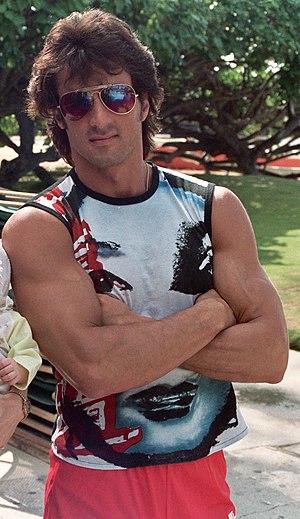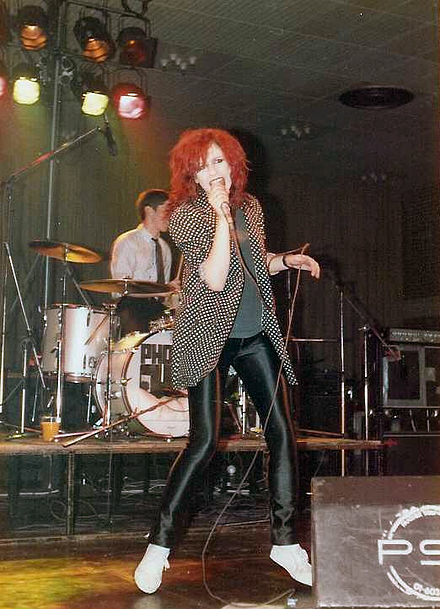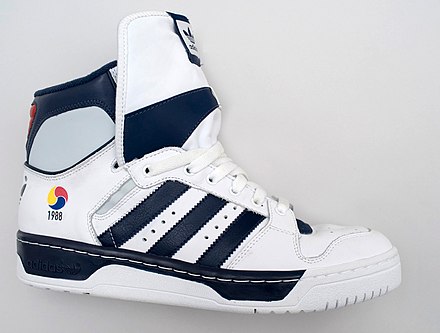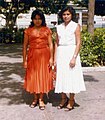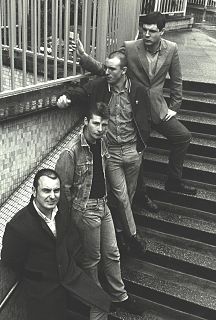

1980s fashion in Britain, America, Europe and Australia had heavy emphasis on expensive clothes and fashion accessories. Apparel tended to be very bright and vivid in appearance. Women expressed an image of wealth and success through shiny costume jewelry, such as large faux-gold earrings, pearl necklaces, and clothing covered with sequins and diamonds. Punk fashion began as a reaction against both the hippie movement of the past decades and the materialist values of the current decade. [2] The first half of the decade was relatively tame in comparison to the second half, which is when the iconic 1980s color scheme had come into popularity.
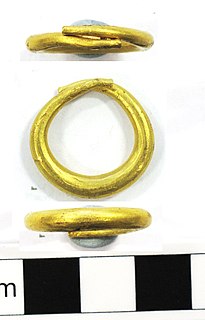
An earring is a piece of jewelry attached to the ear via a piercing in the earlobe or another external part of the ear. Earrings are worn by both sexes, although more common among women, and have been used by different civilizations in different times.

Punk fashion is the clothing, hairstyles, cosmetics, jewellery, and body modifications of the punk subculture. Punk fashion varies widely, ranging from Vivienne Westwood designs to styles modeled on bands like The Exploited to the dressed-down look of North American hardcore. The distinct social dress of other subcultures and art movements, including glam rock, skinheads, rude boys, greasers, and mods have influenced punk fashion. Punk fashion has likewise influenced the styles of these groups, as well as those of popular culture. Many punks use clothing as a way of making a statement.

A hippie is a member of the counterculture of the 1960s, originally a youth movement that began in the United States during the mid-1960s and spread to other countries around the world. The word hippie came from hipster and was used to describe beatniks who moved into New York City's Greenwich Village and San Francisco's Haight-Ashbury district. The term hippie first found popularity in San Francisco with Herb Caen, who was a journalist for the San Francisco Chronicle.
Contents
- Women's fashion
- Early 1980s (1980–83)
- Mid 1980s (1984–86)
- Late 1980s (1987–89)
- Men's fashion
- Early 1980s (1980–83) 2
- Mid 1980s (1984–86) 2
- Late 1980s (1987–89) 2
- Unisex accessories
- Subcultures of the 1980s
- Heavy metal
- Punk
- New Romantic
- Rockabilly
- Rude boys and skinheads
- Casuals
- Skaters
- Rap and hip hop
- Preppy
- Hairstyles
- Women's hairstyles
- Men's hairstyles
- Image gallery
- See also
- Notes
- References
- External links
Hair in the 1980s was typically big, curly, bouffant and heavily styled. Television shows such as Dynasty helped popularize the high volume bouffant and glamorous image associated with it. [3] [4] Women from the 1980s wore bright, heavy makeup. Everyday fashion in the 1980s consisted of light-colored lips, dark and thick eyelashes, and pink or red rouge (otherwise known as blush). [5] [6]

A bouffant is a type of hairstyle characterized by hair raised high on the head and usually covering the ears or hanging down on the sides.

Dynasty is an American prime time television soap opera that aired on ABC from January 12, 1981 to May 11, 1989. The series, created by Richard and Esther Shapiro and produced by Aaron Spelling, revolves around the Carringtons, a wealthy family residing in Denver, Colorado. Dynasty stars John Forsythe as oil magnate Blake Carrington, Linda Evans as his new wife Krystle, and later Joan Collins as his former wife Alexis.

Rouge, also called blush or blusher, is a cosmetic for coloring the cheeks in varying shades, or the lips red. It is applied as a powder or cream.
Some of the top fashion models of the 1980s were Brooke Shields, Christie Brinkley, Gia Carangi, Joan Severance, Kim Alexis, Carol Alt, Yasmin Le Bon, Renée Simonsen, Kelly Emberg, Ines de la Fressange, Tatjana Patitz, Elle Macpherson, and Paulina Porizkova.[ citation needed ]

Brooke Christa Shields is an American actress and model. She was initially a child model and gained critical acclaim at age 12 for her leading role in Louis Malle's film Pretty Baby (1978), in which she played a child prostitute in New Orleans at the beginning of the 20th century. Shields garnered widespread notoriety in the role, and she continued to model into her late teenage years and starred in several dramas in the 1980s, including The Blue Lagoon (1980), and Franco Zeffirelli's Endless Love (1981).

Christie Brinkley is an American model, actress and businesswoman. Brinkley gained worldwide fame with her appearances in the late 1970s Sports Illustrated Swimsuit Issues, ultimately appearing on an unprecedented three consecutive covers starting in 1979. She spent twenty-five years as the face of CoverGirl, has appeared on over 500 magazine covers, and has signed contracts with major brands—both fashion and non-fashion.

Gia Marie Carangi was an American fashion model during the late 1970s and early 1980s. Considered by some to be the first supermodel, she was featured on the cover of fashion magazines, including multiple editions of Vogue and Cosmopolitan, and appeared in advertising campaigns for such fashion houses as Armani, Christian Dior, Versace, and Yves Saint Laurent.









